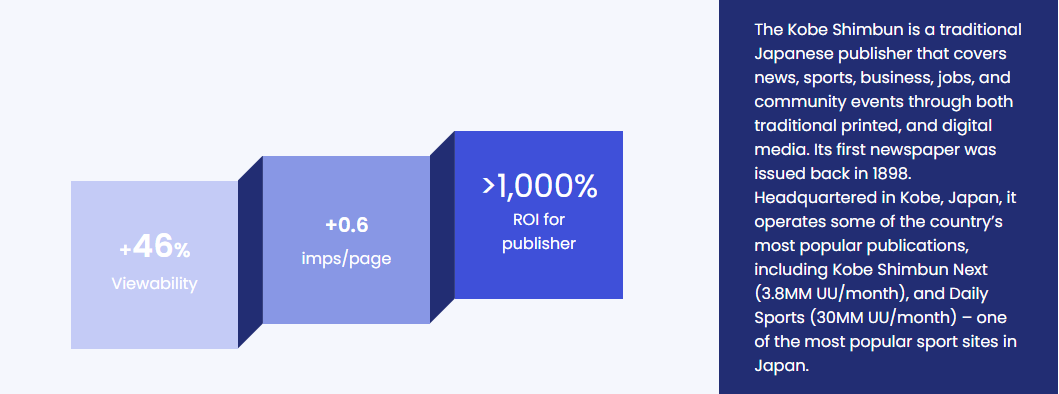How the Kobe Shimbun increased its viewability by 46% with machine learning

Satoshi Ohmachi
Director of digital media
“Using Browsi we’re striking a perfect balance between content and ads – and seeing an increase in revenue while at it! This wouldn’t be possible through manual efforts. It’s rare to have both revenue and editorial teams rooting for the same solution. Can’t believe how easy it was to incorporate such a groundbreaking solution to our ad inventory optimization challenges.”
In the Land of the Rising Sun, a major publisher called The Kobe Shimbun was faced with a dilemma most publishers nowadays have – how do we increase the viewability of our ads, on both desktop and mobile platforms, without sacrificing nor user experience, nor impressions?
They are one of Japan’s main publishers who own, among other media, Daily Sports. It is one of the country’s most popular sports sites, with more than 30 million unique monthly visitors. Headquartered in Kobe, Japan, they also own the Kobe Shimbun Next media site, which has 3.8 million unique monthly visitors.
After trying all of the usual methods, and coming up short-handed, they turned to Browsi, and never looked back. Here is what they tried, what did (not) work, and what the results were:
(Too) ambitious goals
When they first started solving their ad inventory optimization challenges, The Kobe Shimbun had the following viewability on average:
- Daily.co.jp: Desktop 43% and mobile 8%
- Kobe-np.co.jp: Desktop 42% and mobile 24%
- Maidonanews.jp: Desktop 20% and mobile 11%
- They wanted at least 50% viewability on desktop and 40% viewability on mobile.
They wanted to dramatically improve those stats. They tried:
- A/B testing ad layouts and sizes
- Eager loading ads above the fold
- Lazy loading ads below the fold
- Resorting to sticky placements
- Manually moving campaigns between placements in order to hit direct campaign goals
The results were underwhelming, as they were unable to manually adapt to real-time factors such as user behavior, content, devices that access the content, or the ad stack. And who can blame them for only getting so far? between a page loading, and a user consuming it, there’s no time to react (or so one would think), so whatever option they tried – they could only go so far as to satisfy the majority, not everyone.
AI is infinitely faster than a human
Just because a human can’t make notable changes between a page loading and a visitor consuming it, doesn’t mean it can’t be done. With the help of Browsi’s Artificial Intelligence (AI)-powered solution, The Kobe Shimbun was now able to make split-second decisions on viewability, scale and pricing.
Browsi created new ad inventory inside the content, using its user experience (UX) guidelines. In less than a day highly viewable inventory was generated inline.
Here are the results, on average:
- Daily.co.jp:
Mobile – 1.5 impressions per page view with 57% viewability.
Desktop – 0.3 impressions per pageview with 90% viewability - Kobe-np.co.jp – Mobile – 0.9 impressions per page view with 60% viewability.
- Maidonanews.co.jp – Mobile – 0.6 impressions per page view with 65% viewability.

